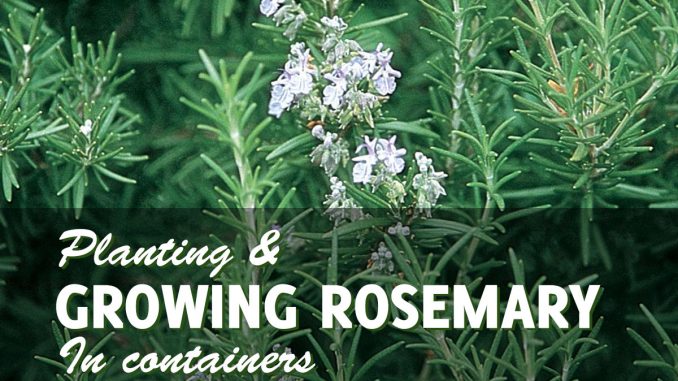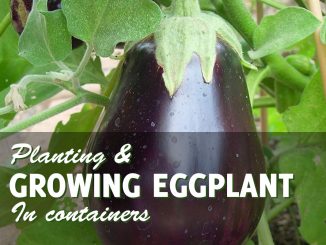
Rosemary (Rosmarinus officinalis) is a fantastic herb. Growing rosemary in pots is relatively easy, filling your home and garden with that rich, pungent aroma. Several varieties give off flowers that are either pink or blue.
As an ingredient, it can add depth and flavor to your dish, often complimenting meat and poultry dishes as well as some cream sauces or vinaigrettes. You will find that the taste of rosemary grown in pots is much better than what the grocery store sells. It may take some time, but once the plant is established, you will have a crop that will give continuous yield that can last for years.
Before You Start Growing Rosemary in Pots
There are different ways to begin growing rosemary in pots. You can either cultivate them from seeds or grow them from cuttings that you have acquired from an established plant. Compared to the two types of cultivation, cuttings are more preferred. Only 15% of the seeds will germinate, and germination also takes a long time.
Selecting the Right Pot to Grow Rosemary
Prepare a pot that is 8-10 inches deep and 12 inches wide. A large container will allow the rosemary to have ample room to spread its roots as well as produce the maximum amount of foliage. The bottom should have adequate draining holes to help get rid of excess water. You may also want to line the bottom with little pieces of broken clay pots topped with small pebbles for better drainage.
Preparing Potting Mix for Growing Rosemary in Pots
The soil used for growing rosemary in pots should be light and drains well. It is easy to kill your rosemary if the soil retains too much water. Rosemary also prefers an alkaline environment with a pH range of 6.0 to 7.5. Buy a potting mix that is low in peat moss since it is acidic; however, acidic soils can be easily remedied by mixing in some lime.
Eggshells can be used as a substitute if lime is not available. Wash them thoroughly and ground them up before you combine them with the soil. Mixing it with perlite will also help lighten the consistency of the soil.
If you are not sure about your mix, request a potting mix that is used for planting cactus in your local garden store. Just remember to test the pH before you plant your rosemary.
Starting Rosemary From Seeds
You can easily buy rosemary seeds online and in your local herb or garden store. When you buy them, make sure that the seeds are new or they will not germinate. See to it that you buy from a reputable store. It is recommended that you sow seeds indoors after the last frost or mid-May. Before you plant your seeds, soak them in water for several hours or overnight.
Place a sterile germination mix on a shallow container. Sprinkle your seeds on top of the germination mix and water them with a water spray with a delicate mist setting until they are moist. Cover them with a light plastic wrap and place them by the window, but away from direct sunlight. If you do not have a window, place them under a fluorescent light.
Germination will take about 3-4 weeks with temperatures of 65°F. Do not expect all of the seeds to grow, and sometimes the seeds will not take in the qualities of the original plant that they came from. You can start transplanting the seedlings once you see four true leaves have formed. When growing rosemary in pots, make sure you place them in a permanent container since it does not does transplant well as it gets older.
Growing Rosemary in Pots From Cuttings
If you wish to have a plant that is very similar to its original form, cuttings are the best way to go about growing rosemary in pots. Use a very sharp knife and cut out a new shoot that is 6-10 inches long at the base, precisely at the point where the shoot is connected to the old plant. Strip off leaves at the base with the use of sharp shears; about 2-3 inches will be enough. You can dip your cutting on a rooting hormone, but that is optional. Once you have done that, sow it in the container and cover it with soil. Layer the top with mature compost and water well. Once they are in the container, it is essential not to disturb your plant, especially once it is established.
Care of Your Pot Grown Rosemary
Rosemary thrives in almost all conditions, but will quickly die when too much attention is given. It prefers sunny conditions, but it can grow by your window sill perfectly as long as there is light. Never overwater when you are growing rosemary in containers as it can kill your plant. Only water when the soil is almost dry.
Fertilizing Rosemary in Pots
Give it an extra boost by giving it compost tea or liquid organic fertilizer once a month. Once your rosemary is established or when it is about 2 feet tall, you can start pruning the branches to tame and shape your plant. Some make their rosemary look like the shape of an open chalice.
Always make sure you give your rosemary plant ample space to grow. Do not water the leaves too, as this will pose a risk of your plant getting sick.
Rosemary Pests and Diseases
The only disease you have to watch out for as you are growing rosemary in pots is powdery mildew. This is a white fungus that grows on your rosemary when there is not enough air circulation because of overcrowding. If this happens, you can scrape the mildew off or spray your plant with water before you do so. Just make sure you help your plant dry up by letting the air circulate, or the problem will come back.
Aphids and spider mites can be a problem. If you see them, pick them out if possible. If not, you may have to prune out the branch that has been infected. You can protect and cure your plant by spraying it with compost tea – just make sure not to over-spray the leaves.
Harvesting Your Rosemary
Harvesting can be done once the plant has reached a size of 2 feet. If you wish to keep tender branches, do not let your rosemary grow beyond 3 feet. Harvest your rosemary by cutting them with a sharp knife or garden shears. You can either dry them by hanging them upside down or putting them in the fridge inside a plastic bag. Freezing can also be ideal for keeping the flavors of your harvested rosemary fresh for a long time.
Growing rosemary in pots is simple. All you need is patience and self-control so as not to give your rosemary too much care and attention. Rosemary dislikes being disturbed or overwatered; just let your rosemary grow and check on it from time to time. Only touch it when necessary. Have a look at our guide on growing thyme in pots if you are interested in other great herbs you can grow in containers.





Be the first to comment